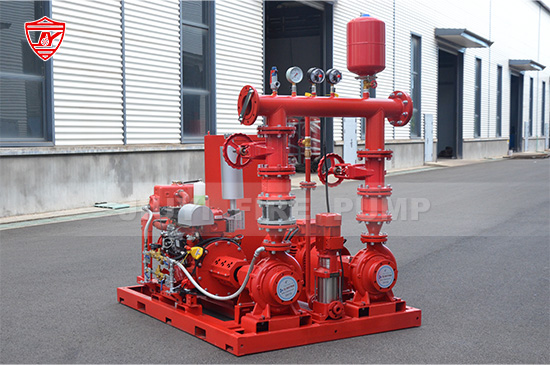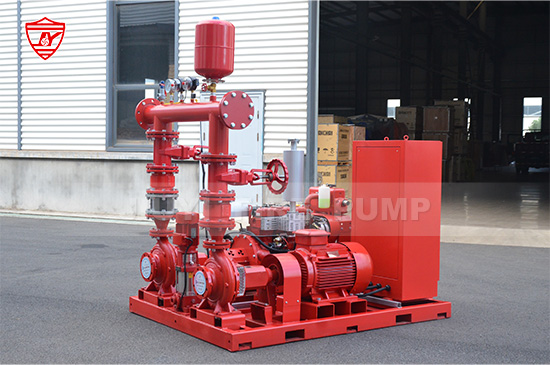In the world of fire protection, fire pumps are the heart of a building’s fire safety system. Whether it’s an electric motor-driven or diesel engine fire pump, these systems are designed to perform reliably under extreme conditions. However, even the most robust systems can face unexpected interruptions or malfunctions. When this happens, knowing how to handle emergency shutdowns properly can make the difference between safety and disaster.
This article explains the causes of emergency shutdowns in fire pump systems, provides a detailed step-by-step guide to manage them, and offers preventive strategies to minimize risks and downtime.

An emergency shutdown refers to an unexpected stop in the fire pump’s operation that is not part of regular system testing or scheduled maintenance. It typically occurs when there is a fault, malfunction, or safety trigger that prevents normal pump operation.
While the term “shutdown” may sound alarming, it is sometimes an essential protective action—either initiated automatically by the control system or manually by operators—to avoid catastrophic damage or unsafe operation.
Common examples include:
Engine overheating in diesel fire pumps
Low oil pressure or high water temperature alarms
Electrical failures or power surges in electric fire pumps
Controller faults or emergency stop activation
System pressure anomalies, such as suction loss or cavitation
Understanding the root causes helps technicians respond effectively. The following are the most frequent triggers for shutdowns:
In electric fire pumps, a power loss or voltage fluctuation can trigger a complete shutdown. Automatic transfer switches (ATS) should immediately transfer power to backup generators, but in some cases, connection faults or delays can cause pump stoppage.
Diesel-driven fire pumps rely on multiple safety sensors—oil pressure, coolant temperature, and overspeed detection. If any reading crosses safe limits, the system automatically shuts down to prevent engine damage.
Overheating can result from blocked cooling lines, improper ventilation, or a faulty heat exchanger. Overheating in diesel pumps is especially critical, as it can lead to engine seizure.
When the suction tank is empty or there’s air leakage, the pump may lose prime, causing cavitation and system vibration—conditions that can quickly lead to damage and automatic shutdown.
Sometimes, accidental pressing of the Emergency Stop Button or misinterpretation of alarm signals can cause unnecessary shutdowns. Proper training of personnel is crucial to prevent these occurrences.
An unexpected shutdown requires a calm, structured response. Following a defined emergency procedure ensures safety and minimizes damage.
Before approaching the pump room, verify that the area is safe. Check for smoke, water leaks, or electrical hazards. Never restart a fire pump until it is confirmed that no fire emergency or safety hazard is in progress.
Knowing whether it’s an electric or diesel fire pump is vital. Each has different safety mechanisms, shutdown triggers, and restart procedures. Identify the control panel type (manual, automatic, or combined) and confirm the indicator lights or alarm status.
Modern fire pump controllers display diagnostic codes or visual indicators that pinpoint the cause of shutdown. Common alarms include:
Low oil pressure
High water temperature
Overspeed
Battery failure
Phase loss or overload
Record all alarm codes before resetting the system. This helps technicians diagnose the exact fault later.
For electric fire pumps, confirm the power source is available and the circuit breakers are not tripped.
For diesel fire pumps, inspect fuel levels, batteries, and exhaust systems to ensure all critical supplies are in order.
Make sure all suction valves are open and water supply is sufficient. Check for any visible leakage or blockage that could disrupt normal suction flow.
Once the root cause has been identified and corrected:
Clear all fault codes on the controller.
Follow the manufacturer’s manual restart procedure.
Observe pump operation closely during restart to ensure it maintains stable pressure and no abnormal noise, vibration, or overheating occurs.
Documenting every shutdown—including time, cause, and corrective actions—is essential for future troubleshooting and compliance. NFPA 25 recommends maintaining a fire pump logbook to track system events and maintenance.
Regular maintenance and monitoring are the best ways to prevent unplanned stoppages. Here are some essential preventive strategies:
Perform weekly visual inspections of the fire pump, controller, and auxiliary systems. Look for signs of oil leakage, loose connections, abnormal noise, or rust.
As per NFPA 25, fire pumps should undergo weekly churn tests and annual flow tests. Regular testing ensures the system operates correctly under pressure and that automatic controls function as intended.
Diesel fire pumps rely on batteries for starting. Replace batteries as recommended by the manufacturer and keep the fuel tank clean and full to avoid air or water contamination.
Install monitoring systems to continuously track:
Oil pressure
Engine temperature
System pressure
Electrical current load
Early detection of irregularities prevents sudden shutdowns.
Untrained personnel may accidentally trigger shutdowns or delay critical responses. Conduct regular fire pump operation training, focusing on control panel functions, alarm interpretation, and emergency actions.
Downtime can be minimized when essential components like relays, sensors, and filters are available for immediate replacement.
NFPA 20, the Standard for the Installation of Stationary Pumps for Fire Protection, provides specific guidelines on shutdown procedures. According to the standard:
Emergency shutdowns should only occur under life-threatening or equipment-damaging conditions.
The controller must have manual restart capability after the fault is cleared.
Automatic shutdowns should be minimized to ensure the fire pump remains operational during active fire conditions.
Maintaining compliance with NFPA 20 not only ensures system reliability but also supports insurance and inspection requirements.
If the cause of the shutdown is unclear or involves major system components, such as:
Controller malfunction
Engine mechanical failure
Electrical short circuits
Pump impeller or seal damage
It is essential to contact a qualified fire pump technician or the manufacturer for inspection and repair. Attempting to restart without resolving the underlying issue can lead to further equipment damage or operational hazards.
A well-prepared emergency response plan is the cornerstone of effective fire safety management. Your plan should include:
Clear shutdown and restart procedures
Contact information for maintenance and emergency service teams
Regular staff drills and documentation
Backup water supply and alternate pump arrangements
When everyone on the team understands their responsibilities and the steps to take, the system’s reliability improves dramatically.

Fire pump emergency shutdowns are rare but critical events. Proper understanding, immediate action, and adherence to NFPA standards can significantly reduce risks and ensure system integrity.
As a professional fire pump manufacturer, we strongly recommend regular testing, preventive maintenance, and operator training to maintain peak performance. When handled correctly, even an emergency shutdown becomes an opportunity to reinforce safety and reliability within your fire protection system.